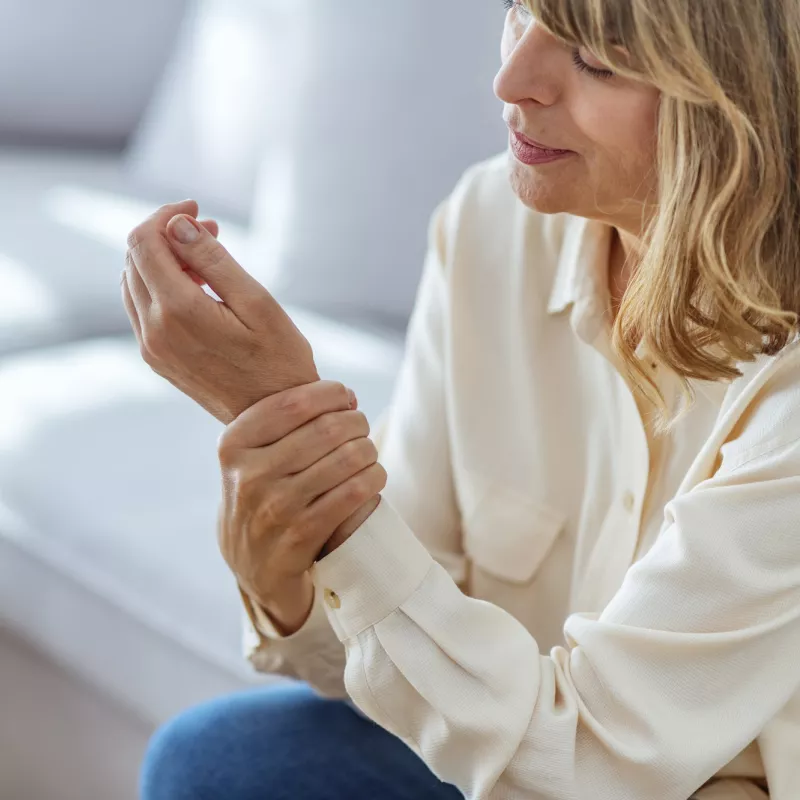Top Ten Things To Do For Arthritis
1. Get a Proper Diagnosis
Many causes of joint pain are not related to arthritis. These include fractures, nerve damage (sciatica from back problems), a torn meniscus (knee) bursitis, synovitis, tendonitis, myositis, and even cancer. Always get a proper diagnosis first.
2. Start an Exercise Program
Moderate exercise is an integral part of treating arthritis. Although exercise may sometimes cause discomfort, proper exercise will help nourish the cartilage, strengthen the muscles and may prolong the life of your joints. Check with your doctor before starting any exercise program to obtain permission, precautions or guidelines.
3. Modify Your Activities
Proper body mechanics can lead to a more effective use of your body and less strain on your joints. Following these activity modification guidelines may prove helpful:
- Avoid slouching and practice good posture by standing up straight.
- Avoid sitting in low chairs to reduce stress on your knees when sitting and rising.
- While traveling, get up and move around every hour or so to avoid stiff joints.
- Avoid impact-loading activities (running, etc.).
4. Nutritional Supplements
Recently, nutritional supplements have become popular with patients with arthritis. Glucosamine and Chondroitin have been the most widely used.
Glucosamine – This natural building block found in cartilage may also be labeled as a hydrochloride or sulfate. Studies have shown Glucosamine to be useful in strengthening, repairing and revitalizing cartilage, and in reducing pain.
Chondroitin Sulfate – This supplement is commonly taken along with glucosamine. It is found in cartilage and acts like a sponge for the fluid found in cartilage. This makes the cartilage more elastic and spongy. Chondroitin may also help prevent the breakdown of cartilage.
Vitamin C and D – Some studies indicate that patients low in Vitamin C and D may have a higher incidence of arthritis. Although a direct cause and effect is not established, it is recommended that arthritis patients take vitamins regularly.
Calcium – Some people confuse osteoporosis with osteoarthritis. Osteoporosis is thinning of the bone, not the joint. Calcium is known to help strengthen the bones and may help prevent the onset of osteoporosis.
Consult with your physician before beginning any new medications.
5. Apply Heat/Cold
Heat and/or cold may be used to decrease pain and increase flexibility. Cold decreases blood flow and helps relieve joint pain and swelling. Heat increases blood flow and helps relax muscles.
HEAT COLD
Use heat prior to exercise -- increases local circulation. Use cold after exercise -- decreases local circulation.
6. Use Orthotics/Bracing/Self-Help Devices/Support
Simple everyday tasks are difficult to accomplish when your joints hurt. Ask your doctor or physical therapist about self-help devices for the feet, knee, hands/wrist or back-hip-knee.
Support – Support devices such as canes, walkers or crutches may also help with pain and discomfort. Talk to your doctor if you feel these might help you with support and balance.
7. Investigate Over-the-Counter Medications
Medications are important in the treatment of arthritis. Many over-the-counter (OTC) medications are effective in patients with arthritis with few side effects.
Pain-relievers such as Tylenol® are generally safe and effective in relieving minor pain and discomfort however, they do not reduce the inflammation caused by arthritis. Nonsteroidal anti-inflammatory drugs (NSAIDs) such as Motrin,®Advil® and Aleve® help relieve joint swelling and inflammation.
The American College of Rheumatology recommends Capsaicin cream or gel as part of the treatment plan. Other creams may be found to be useful as well. Always check with your doctor before starting any medication or supplements.
8. Ask About Prescription Medications
When OTC medications are ineffective in reducing the pain, swelling, and stiffness from arthritis, prescription medications may be helpful. There are four general classes of prescription medications:
- NSAIDS – NSAIDS reduce the production of prostaglandins, which is a major cause of pain and swelling in arthritis patients. The drug blocks the COX enzyme, which exists in two forms: COX 1 (good) and COX 2 (bad). Traditional NSAIDS such as Motrin block both of these enzymes.
- Non-Narcotics – Several drugs, such as Ultram (Tramadol), are usually well tolerated and effective for pain relief. They work by reducing the brain’s recognition of pain. Many other combinations with Tylenol give these drugs a variety of names.
- Narcotics – Narcotic medication is usually reserved for severe pain of a short duration. These include medications such as Percocet, Lortab and Demerol. They work by reducing brain recognition of pain but have significant side effects such as drowsiness, nausea, constipation and addiction. As most arthritis pain is chronic (longstanding), narcotics are generally not used in people with arthritis.
- Rheumatoid, Lupus Drugs – There are many excellent medications today for patients with rheumatoid arthritis and other inflammatory diseases. These complex drugs include Methotrexate, Plaquenil, Remicade, Arava, Enbrel, Prednisone and others. They are used mainly by rheumatologists, internists and family doctors. Your orthopedic surgeon may refer you to one of these specialists for care if you might need one of these medications.
9. Consider Injections Cortisone Injections – Injecting Cortisone directly into joints helps relieve both swelling and pain
Cortisone is a naturally occurring hormone produced by the adrenal gland that helps for months. The effect occurs usually within a day or two of the injection.
The long-term use of cortisone injections is controversial. Cortisone may play a role in weakening tendons or cartilage if used too often. Most doctors limit its use to a few times a year depending on the circumstances.
Hyaluronate Injections – Hyaluronate injections have been approved for arthritis of the knee. The injections may help relieve osteoarthritis pain and restore joint function. Hyaluronate is a naturally occurring substance in joint fluid that provides lubrication and cushioning to the joint.
Several synthetic forms of hyaluronate have been developed for use in the knee joint. To be effective, you must receive three to five injections weekly. The effectiveness is usually not noticed for a month or so.
Studies have shown that the more severe the arthritis, the less effective the injections. When effective, however, the relief may last six months to a year. Injections may be repeated in six months.
10. See a Surgeon who specializes in Arthritis
Surgeons who specialize in arthritis can provide you with all the options and expertise to decide whether surgery is right for you.
Knee Surgery Options
Arthroscopy – Arthroscopy is a form of surgery where surgeons place small instruments through punctures into your knee joint. Damaged tissue can be removed or repaired within the joint providing relief from both pain and swelling while possibly preventing further damage to the knee. This procedure is usually not helpful if you are suffering from severe arthritis.
Total Knee Replacement – For patients with significant arthritis, your surgeon may recommend knee replacement surgery. Knee replacement involves replacing the worn-out surfaces of the knee with metal and plastic components.
Partial Knee Replacement – The knee is composed of three compartments. Osteoarthritis sometimes develops in only one compartment, while the other two remain relatively healthy. Patients who have osteoarthritis in only one compartment may be candidates for a partial knee. The advantage of a partial knee is that it resurfaces only the damaged cartilage of the knee, preserving the undamaged cartilage. You and your surgeon will determine if a partial knee replacement is right for you.
Hip Surgery Options
Hip Replacement – Total hip replacement replaces the ball on the upper end of the femur (thigh bone) and resurfaces the acetabulum (socket). Resurfacing the ball on the upper end of the femur instead of replacing it is sometimes done in younger patients. These implants are designed to restore function and eliminate as much discomfort as possible while allowing you to return to a more active lifestyle.
Other Forms of Arthritis
Shoulder – Arthritis of the shoulder that results in pain and stiffness may necessitate a shoulder replacement. The ball end of the shoulder is replaced with a metal ball. The socket may or may not be resurfaced with plastic. The hospital stay is typically one to two days. Therapy usually continues for three months or more.
Ankle – Arthritis of the ankle can be quite painful. Two options exist. Fusion of the ankle is most common and works well. Occasionally total ankle replacement is performed.
Hands/Wrist/Elbow – These joints can often be treated without surgery. However, in some cases either fusion or replacement is performed.

Experienced Orthopedic Care for Arthritis
You deserve to find relief from chronic arthritis pain, and our experienced orthopedics team is ready to help you feel better. Count on us to help you regain your rhythm and move pain-free with individualized therapy plans.

